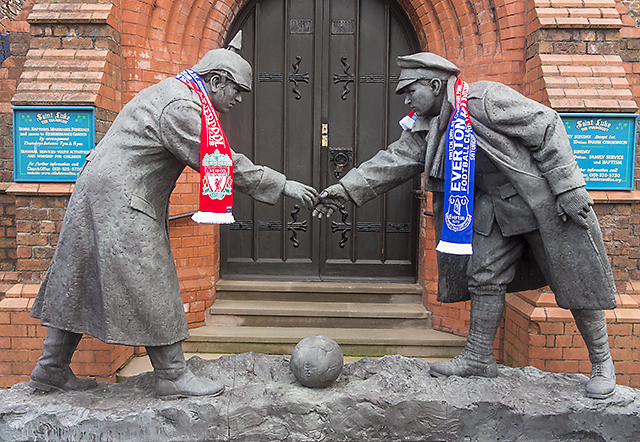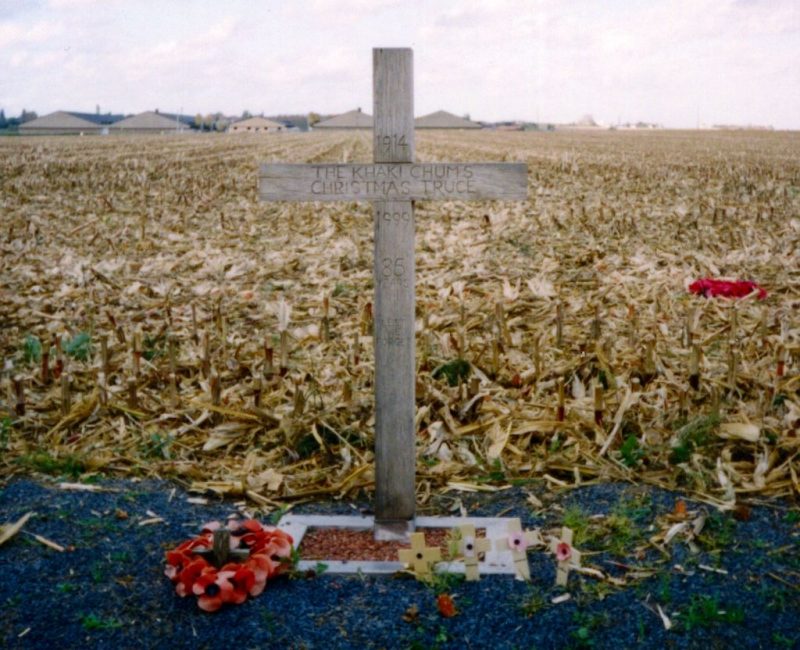Image Used: ‘All Together Now’, a sculpture by Andy Edwards commemorating the ‘WWI Christmas Truce’ on display at St Luke’s Church near Goodison Park in February 2014. It represents the moment when British and German troopers stopped fighting for a game of football on Christmas Day, 1914.
Blurton-born sculptor Andy Edwards carved a touching statue entitled ‘All Together Now’ commemorating a football match and Christmas Day Truce between the British and German WWI combatants in 1914. Web edition of renowned British daily tabloid newspaper, Daily Mirror reported on the unveiling of the sculpture. In the statue, two enemy soldiers made in ‘clay and resin’ are seen facing each other about to shake hands with outstretched arms. It depicts one of the most astounding and expressive moments in the history of warfare.
Germany initially attacked through Belgium into France within the first 5 months of WWI. French and British combatants resisted the German invasion outside Paris in September 1914 and the Germans fell back to Aisney Valley in northeastern France. The Germans had taken defensive positions and the allies were not being able to push through the German line. After several months the British forces had been withdrawn from Aisne and sent north into Flanders and stalemates prevailed almost everywhere. There was a continuous font line running from Swiss frontier to the North Sea and both sides were occupied by opposing troops in defensive positions. The static nature of Trench warfare often made some of the frontlines in the Western Front significantly quiet and sometimes, even fraternization among enemy soldiers took place.
A series of unofficial ceasefires occurred on a large scale along the WWI Western Front during the weeks leading up to the Christmas holiday in 1914. One remarkable incident occurred when two opposing forces, the British and the German soldiers, crossed trenches to exchange Christmas greetings and talk on Christmas Eve and Christmas Day. The soldiers played games of football with one another, exchanged souvenirs and food, there were prisoner swaps, joint burial ceremonies and several meetings ended in singing carols together. British poet and writer Robert Graves reconstructed the reported football match between the British and German soldiers in one of his story where he added some fiction and mentioned that the score of the match was 3-2 to the Germans! The unique truce reflected a good mood of ‘live and let live’. Even in some sectors, occasional ceasefires used to take place to allow soldiers to go between the lines and retrieve the wounded and bring back the dead comrades. Some other sectors would follow the tactical agreement of not shooting while the enemy soldiers rested.
These truce events had been published in New York Times on December 31, 1914 with a positive tone and the British papers soon followed. British tabloid dailies the Daily Mirror and Daily Sketch (publication ceased in 1971) printed the mingling and singing photographs of British and German troops in the front pages. British daily the Times mentioned of a ‘lack of malice’ felt by both sides of the war and Daily Mirror regretted that after the temporary truce ‘absurdity and the tragedy’ would begin again. The media coverage in Germany was different though with some newspapers severely criticized the Germans who took part in the fraternization and did not publish any photographs. France ensured censorships but the stories were spread by the wounded soldiers in the hospitals. French officials reprinted a Government notice that fraternization with the enemy can be incorporated with treason and in January, 1915, it was published that the truce had happened on the restricted sectors of the British front only. The French official statement also affirmed that a little exchange of songs between the opposing forces had been quickly degenerated into shooting.
However, the peaceful atmosphere was not omnipresent during the Christmas holiday and some sectors continued fighting. Ceasefires were arranged by fewer units in the following year as there had been strict orders from the high officials of both sides restricting Fraternization. By 1916, soldiers were no longer responsive to truce. War had become increasingly devastating and bitter with large number of deaths and casualties.
Image Used: A cross left in Saint-Yves in 1999, commemorating the site of the Christmas Truce. The text reads: “1914- The Khaki Chum’s Christmas Truce -1999 -85 Years, Lest We Forget”
The 8ft clay sculpture was built at the Wedgewood factory in Barlaston. In the sculpture, a British soldier from the Staffordshire Regiment is seen shaking hands with a German soldier in no-man’s land. They appear to be shaking hands but not quite touching and a space is formed in which the visitors can insert their own hands to complete the union. The sculpture is scheduled to travel to Germany. Then it would be taken to Flanders to be temporarily installed on the WWI Christmas Day truce site. Its creator Andy, who was also behind carving the famous Stanely Matthews monument outside Stoke City Football Club, said that letters from lads in the local Staffords showed many had taken part in the truce and the game, only for the terror of war to resume and take them. He also said that some had seen the match as a mercy, so they could get away from the carnage. He added that today, the sons and nephews of his fellow pottery workers still facing the same situation in wars across the world. He urged all to call for a worldwide truce.
It is hoped that funds would be raised for the sculpture to cast the statue in bronze and then a permanent home could be found for it. WWI Christmas Truces are often seen as symbolic moments of humanity and peace amidst rampant violence.
Video Used: Video clips showing some WWI battles and praising the WWI Christmas Truce of 1914

